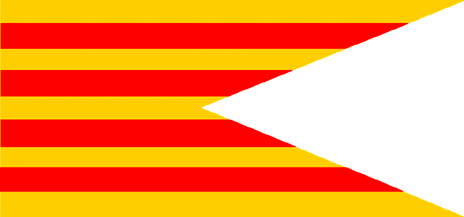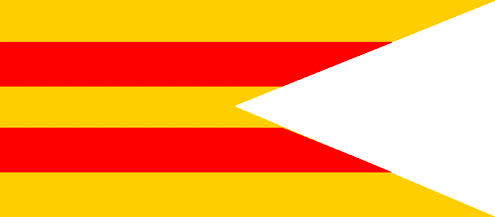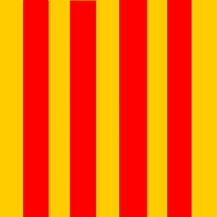The royal flag in the 15th century
The Catalan royal flag is a dynastic flag, in no case originating from Aragon, and on the other hand originated perhaps in Carcasona where the dynasty had its origin. When James II delivered to his son Alfons the flag that he will carry to the expedition to Sardinia, says to him in Catalan (translation): "my son, I give you our flag, ancient, of the principality of Catalonia".
The number of stripes was fixed definitely in four by Peter the Ceremonious in 1344. At some point beyond this era the arrangement of the four stripes is generally respected by the artists that make or reproduce the flags. The most usually reproduced is the swallowtailed with four stripes

We have already seen flags with four stripes in Barcelona and Majorca (see Bulletin 10)
A quartered flag appears in Montpellier with the cross of Saint George (quarters 2 and 3) and red disk on yellow (quarters 1 and 4)

Flag quartered in saltire (bars and eagle of the Hohenstaufen) appears often in Sicily.

In the book "The flag of Catalonia" is reproduced a flag granted by king Martin to the weavers’ guild.

Red flag with three yellow stripes, published by Domenech.

Flag drawn in the "taula of Sant Jordi" by Pere Niçard, at the diocesan Museum of Majorca City.

Flag drawn in the "predel-la of Sant Jordi" at the Diocesan Museum of Majorca City

Flags originating from the Dietari de la Casa of Barcelona.



Flags published by W. Smith (FTTAATW pag. 142), Catalan flags in Naples: show the pennant with two red stripes

and a square flag with four red bars (only three are clearly visible in the drawing)

Porter mentions the pennant as three-striped.

A variant of the pennant of two stripes appears in the altarpiece of Sant Jordi of Marçal of Sax painted around 1400, in the altarpiece of Sant Jordi of Xerica (c. 1425) probably by the same painter, and in a miniature of Llornard Crespi (c. 1440)

The galleys of the kingdom, by royal decree of 1396, only could hoist the distinctive flag of the county of Barcelona. Calvo and Grávalos show the flag in their book, illustration 109.

In the tapestries of the " Conquest of Tunis" in the Royal palace of Madrid, appear some flags: the first horizontal with two red stripes and two yellow; the second red with two yellow stripes.


Upon acceding to the throne Ferdinand of Antequera, first king of the dynasty of Castilian origin known as the Trastamara, adopts as royal symbol the bars of the counts of Barcelona and kings of Aragon.
The guidon of the last king, Ferdinand the Catholic, was vertical with four bars. Ferdinand died in 1516 giving way to the dynasty of the Austrias, begun by emperor Charles V of Germany and I of Catalunya, Aragon and Castille.
